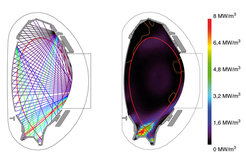Sophisticated miniatures: IPP developing bolometers for ITER
Contract for almost five million euros: diagnostic method for ITER being developed
The contract for developing an important diagnostic method for the ITER international test reactor went to Max Planck Institute for Plasma Physics (IPP) at Garching: The ITER Fusion for Energy Agency will be funding a German research and industrial consortium, headed by IPP, with a total of 4.8 million euros in the next four years. The objective is advanced development of so-called bolometer cameras for recording the heat and X-radiation emitted from the ITER plasma. Award of the contract was based on a preparatory phase supported with national project funds in which the participants’ suitability for this and other ITER tasks was verified.

The measuring method is to record the heat and light emission from the infrared to X-ray region and pinpoint their origin in the plasma. The radiation power is part of the total energy balance of the plasma. It has to be known in order to control the plasma or apply certain modes of operation.
Measuring principle of a bolometer: A metal plate the size of a postage stamp absorbs the radiation emitted from the plasma along a narrow line of sight, thus heating up. The electric resistance of a conductor located below it changes according to the temperature and is therefore a direct measure of the radiation power. Additional calculations and measured data allow the radiation to be assigned to its origin in the plasma insofar as a sufficient number of bolometers are available. This reveals exactly what site in the plasma has emitted what power.
This measuring method, developed at and patented by IPP, has been successfully applied for many years. However, the ITER large-scale device, which is to produce a burning fusion fire for the fist time, imposes new requirements: Unlike hitherto, the detectors have to withstand impinging fusion neutrons and also be capable of working reliably at temperatures of up to 450 degrees.

For this further development IPP have since 2008 been using funds provided by the Federal Ministry of Research to pursue fruitful cooperation ventures: For example, previous IPP designs were used to develop first prototypes at the Institut für Mikrotechnik Mainz – platinum absorbers galvanically deposited on thin ceramic membranes. They have already passed neutron tests in the research reactor of the Hungarian Academy of Sciences and their spectral sensitivity has been tested in cooperation with Germany’s Physikalisch-Technische Bundesanstalt. Heat tests at IPP, however, were only partially successful. Modelling calculation with the support of the KRP Mechatec company subsequently helped to modify the design appropriately. Alternatives for the absorber material and its suspension are also being investigated.
Later about 500 lines of sight will traverse the ITER plasma and observe it from all angles in various cross-sectional planes. The absorber plates, which pick up this radiation, are located deep in the wall of the plasma vessel – at the end of long ducts covered with narrow diaphragms: the smaller the angle of sight scanned by the individual detector, the more precisely is the plasma imaged. The large ITER plasma also calls here for much higher requirements than do present-day fusion devices.
To test the accuracy attainable, a robot test rig was specially installed in conjunction with a doctoral thesis and tested in the plasma vessel of the ASDEX Upgrade fusion device at Garching. It can direct a laser beam from all directions to the entry slot of a bolometer. The measured results helped to improve the diaphragm design so as to largely suppress scattered light and reflection in the camera. Much in the way of optics, assembly, material and electronics still needs to be optimised until in four years a fully documented prototype integrable in the ITER design becomes available.
Isabella Milch

